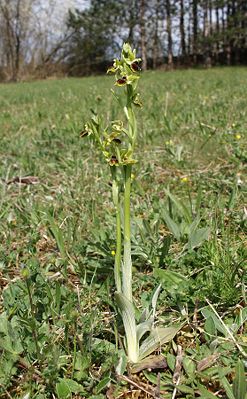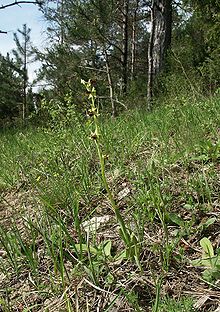Small spider ragwort
| Small spider ragwort | ||||||||||||
|---|---|---|---|---|---|---|---|---|---|---|---|---|

Little Spider-Ragwurz ( Ophrys araneola ) |
||||||||||||
| Systematics | ||||||||||||
|
||||||||||||
| Scientific name | ||||||||||||
| Ophrys araneola | ||||||||||||
| Rchb. |
The Small spider orchid ( Ophrys araneola ) is a plant from the plant genus Ragwurzen ( Ophrys ) within the family of orchids (Orchidaceae).
description
Appearance and leaf
The small spider ragwort grows as a deciduous, perennial herbaceous plant that reaches heights of 15 to 45 centimeters. This geophyte forms tubers as persistent organs. The leaf rosette is relatively large and can occasionally be found in small groups. The foliage leaves have the silvery "shimmer" typical of the Ragwurzen , which is slightly more pronounced than that of the Great Spider-Ragwurz ( Ophrys sphegodes ).
Inflorescence and flower
Two to twelve flowers are loosely together in an annual inflorescence .
The hermaphrodite flowers are zygomorphic and threefold. The bracts of the outer circle of perigone are green and about 10 millimeters long. The two inner lateral bracts are also green, very rarely with a reddish edge and 6 to 8 millimeters long. The middle bloom called the lip (labellum) is reddish-brown to black-brown with a mostly clear yellow, hairless edge. It is usually only slightly arched, usually without bumps, 6 to 9 millimeters long and 7 to 11 millimeters wide. At the transition from the brown area to the yellow border it is very hairy. The mark is H-shaped and metallic-blue to gray-blue, rarely also brownish.
The flowering period begins in February in the Mediterranean climate . In the northern distribution areas, the flowering period begins at the end of April, rarely from the beginning of April and lasts until the end of May. It starts earlier than the Great Spider-Ragwurz.
Chromosome set
The basic number of chromosomes is x = 18. The small spider ragwort has diploidy , i.e. 2n = 36.
ecology

The seed of this orchid does not contain any nutrient tissue for the seedling . The germination therefore takes place only when infection by a root fungus ( mycorrhiza ).
Ecologically flowers is in the little spider orchid to Sexualtäuscheblumen that mimic the lip insect females by their scent, their appearance, size and condition and cause the earlier hatching insects males to the flowers lips Kopulationsversuche to make. The pollinia with their separate adhesive disks are cemented to the head of the male insect. The stalk of the pollinarium sinks down after removal and can cover the stigma, which is at the appropriate height, with pollen when the next flower is visited. The following are considered pollinators : Osmia aurulenta and Andrena combinata .
distribution
The distribution area of the small spider plant extends from Catalonia , France , Germany , Switzerland , Italy to Dalmatia . It is the rarest autochthonous species in Germany . In Germany there are few locations in Baden-Württemberg , Lower Franconia , Thuringia and Rhineland-Palatinate . In Switzerland it occurs only in the north and west. According to Baumann and Künkele , the species occurs in the Alpine countries in the following altitude limits: Germany 220–810 meters. France 1–1330 meters, Switzerland 200–800 meters. In Europe it occurs between 1 and 1330 meters above sea level.
The small spider ragwort grows on dry grass and in sparse pine forests. It prefers rockier and drier locations than the Great Spider-Ragwurz . It is found in the plant communities of the associations Mesobromion erecti, Geranion sanguinei and Molinion caeruleae.
Possibility of confusion and hybrids
Because of its similarity to the Great Spider-Ragwurz ( Ophrys sphegodes ), the Small Spider-Ragwurz was often not differentiated from it earlier and even today. It is quite possible that the distribution of the small spider ragwort in Central Europe is greater than previously assumed.
The best way to differentiate between the two species is by the size of the lip, which is smaller in the small spider-ragwort. It becomes difficult, however, if the hybrid Ophrys × jeanpertii occurs between the two species. Then usually no clear line between species and hybrid can be drawn.
As a result of global warming - like other warmth- loving orchid species - the small spider orchid is spreading. In the meantime, some new finds have been made, mostly in places where the Great Spider-Ragwurz already occurred. Due to their somewhat more specific requirements, there are limits to this spread.
- Nature hybrids :
- Ophrys × apicula J.C. Schmidt ex Rchb. f. ( Ophrys araneola × Ophrys insectifera )
- Ophrys × acina C.E. Hermos. (Syn .: Ophrys × cascalesii Soca ; Ophrys araneola × Ophrys passionis )
- Ophrys × duvigneaudiana P. Delforge & C. Delforge ( Ophrys araneola × Ophrys scolopax )
- Ophrys × jeanpertii E.G.Camus ( Ophrys araneola × Ophrys sphegodes )
- Ophrys × luizetii E.G.Camus ( Ophrys araneola × Ophrys apifera )
- Ophrys × pourteiniae J.M. Mathé ( Ophrys araneola × Ophrys fusca )
- Ophrys × pulchra E.G. Camus ( Ophrys araneola × Ophrys holoserica )
Taxonomy
The name Ophrys araneola was first published in 1831 by Ludwig Reichenbach .
There is also the view that Ophrys araneola Rchb. a subspecies of Ophrys sphegodes is: Ophrys sphegodes subsp. araneola (Rchb.) M.Laínz .
Danger
Due to its rarity, the small spider ragwort is generally endangered. Outside of nature reserves endangered by succession . Within nature reserves by nature lovers who do not adhere to the route.
Sources and further information
literature
- AHO (Ed.): The orchids of Germany . Verlag AHO Thuringia Uhlstädt - Kirchhasel, 2005, ISBN 3-00-014853-1 .
- Karl-Peter Buttler : Orchids, the wild species and subspecies of Europe, the Middle East and North Africa . Mosaik Verlag 1986, ISBN 3-570-04403-3 .
- Hans Sundermann : European and Mediterranean orchids . Brücke-Verlag, 2nd edition: 1975, ISBN 3-87105-010-5 .
- JG Williams: Orchids of Europe with North Africa and Asia Minor . BLV Verlag, ISBN 3-405-11901-4 .
- Oskar Sebald, Siegmund Seybold, Georg Philippi, Arno Wörz (eds.): The fern and flowering plants of Baden-Württemberg. Volume 8: Special part (Spermatophyta, subclasses Commelinidae part 2, Arecidae, Liliidae part 2): Juncaceae to Orchidaceae. Eugen Ulmer, Stuttgart 1998, ISBN 3-8001-3359-8 .
- Schiestl, FP and Vereecken, NJ (2008) Andrena combinata, a new pollinator of Ophrys araneola. J. Eur. Orch. 40 (1): 65-71
Individual evidence
- ↑ a b Helmut Baumann , Siegfried Künkele : Orchidaceae . In: Oskar Sebald u. a .: The fern and flowering plants of Baden-Württemberg . 1st edition Volume 8, page 413. Verlag Eugen Ulmer, Stuttgart 1998. ISBN 3-8001-3359-8
- ↑ Rafaël Govaerts (ed.): Ophrys. In: World Checklist of Selected Plant Families (WCSP) - The Board of Trustees of the Royal Botanic Gardens, Kew . Retrieved May 10, 2020.
- ^ Helmut Baumann , Siegfried Künkele and Richard Lorenz: Orchids in Europe with adjacent areas . Verlag Eugen Ulmer, Stuttgart, 2006, page 194.
Web links
- Ophrys araneola Rchb., Small Spider-Ragwurz. In: FloraWeb.de.
- Small spider ragwort . In: BiolFlor, the database of biological-ecological characteristics of the flora of Germany.
- Profile and distribution map for Bavaria . In: Botanical Information Hub of Bavaria .
- Thomas Meyer: Data sheet with identification key and photos at Flora-de: Flora von Deutschland (old name of the website: Flowers in Swabia ).
- Distribution map: Germany (working groups domestic orchids) as Ophrys sphegodes subsp. litigiosa
- Distribution map : Switzerland (AGEO)
- Regional links




